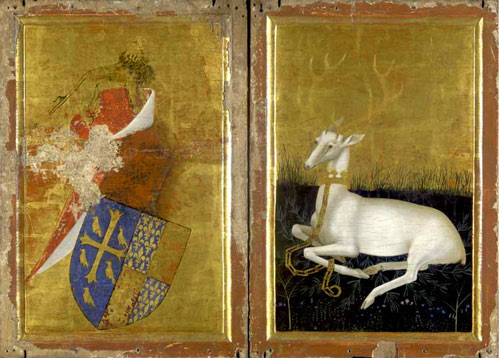The Wilton Diptych is one of the oldest and most luxurious works in the National Gallery’s collection. This gold covered diptych was made some time between 1395 and 1399 by English or French craftsmen for King Richard II of England, it is laden with symbolic imagery connected with Richard and his divine right to rule, not just in its subject matter but also in the materials and techniques involved in its making.

In order to appreciate the full meaning of the Diptych, one must first know something of its patron and subject, Richard II. Only ten years of age when he came to the throne, most of his regal powers were passed to his protector and uncle John of Gaunt, Duke of Lancaster. In the meantime, Richard received an education and developed a skill for, and love of, the French language alongside the study of scripture. This education, without the pressures of ruling, had a great impact on Richard’s development, as the historian Caroline Barron writes, “He developed a concept of kingship which emphasised the priestly rather than military aspects.”
At the age of only fourteen the juvenile king successfully faced off the Peasants Revolt of 1381 but this was by no means the worst crisis of his reign, in 1388 his court was purged of suspected traitors, many of them his close friends, and he nearly faced deposition before he’d even taken full possession of his powers. It was not until his twenty-first birthday in 1389 that Richard finally took full control of England, but this was not to last. Only a decade later, in 1399, Richard finally was deposed by his cousin Henry, Duke of Derby. Richard is thought to have died of starvation whilst a prisoner of his cousin.

With this biography in mind, we turn to the object itself. The best-preserved parts of the diptych are the two inside panels, these show Richard greeted by the Virgin and Christ in an exchange that crosses the divide between the wings. The left panel contains a row of three saints, each identifiable by their attributes, with King Richard kneeling in front of them. From left to right they are St Edmund holding an arrow as a symbol of his martyrdom, Saint Edward the Confessor holding the ring that he gave to a beggar who turned out to be John the Evangelist, and St John the Baptist identified by his traditional fur cloth. For Richard these were three very important saints, Edmund and Edward were both Kings of England with whom Richard felt a strong connection. It is reported that during Richard’s coronation both the slippers of St Edmund and the crown of St Edward were used as ceremonial items. To complete the set, John the Baptist was Richard’s patron saint, he was born on the day of the feast of the baptism of Christ and because he ascended to the throne on the eve of the vigil of the Baptist.
The materials and techniques used in this panel exude opulence and wealth. This is particularly the case with the gold leaf background that covers this panel and the whole diptych. In the left panel it has been intricately tooled in a repeating floral pattern that would have taken many man-hours to produce by hand. Wealth and prestige is also communicated through the clothing of the saints and the King, their crowns are embedded with small jewels, the result has been described by Neil MacGregor as “half way between painting and goldsmith’s work.”
Although it is in the cloaks of Richard and Edmund that we see real luxury. Here, using a technique known as sgraffito, the gold has been revealed by scraping away the pigment on top. This allows the artist to create two different textures on the clothing suggesting two different fabrics. This is particularly significant in the case of Edmund’s cloak where hugely expensive ultramarine pigment has been scrapped away. The iconography in the design of Richard’s cloak has been proposed to be symbolic of his first marriage to Anne of Bohemia as, other than his own symbol of a white heart, the eagles in the design reflect those found on the arms of Bohemia in that period.
Richard’s symbol, the white hart, is prevalent throughout the diptych. The reverse side of the left-hand wing is dedicated solely to a depiction of the hart laying on a bed of rosemary with a golden crown and chain around its neck. It is thought that Richard adopted this symbol from his mother, Joan of Kent, with whom he was very close. In another level of personalisation, the Rosemary that the hart lies on was another of the symbols of his first wife Anne.
The hart appears again as a badge on the breast of all the angles on the inside right wing. It is almost as if Richard is laying claim to these heavenly beings – or maybe he is merely stating that they are on his side, his supporters. Indeed, this would chime with the narrative commonly read into this piece, that it is centred on ideas of the divine right of monarchy.
The standard that is passed from the Virgin and child to Richard was for a long time thought to represent the resurrection of Christ, however cleaning in the early 1990s revealed details within the orb on the top that suggest another story. Inside there is a depiction of a white castle on an island with trees, alongside is a ship in full sail on what was originally (it is now tarnished) a sea made of silver leaf. This discovery changes the interpretation of the standard which, it is now generally agreed, represents England itself with the flag of St George supporting this theory. There is speculation that this detail may also be the subject of those famous lines from Shakespeare’s Richard II: “This royal throne of kings, this sceptered isle [….] this little world, This precious stone set in the silver sea, Which serves it in the office of a wall Or as a moat defensive to a house, Against the envy of less happier lands,–This blessed plot, this earth, this realm, this England.” Although we can never know whether Shakespeare could have seen the diptych, let alone been aware of this particular detail….but it is a tantalising speculation.
So now the narrative can be read as Christ and the Virgin giving England to Richard, an act that supposedly takes place at the moment of coronation. This may account for the depiction of Richard as such a young man, at the time of making he would have been around thirty years old, not the fresh faced young boy seen in the diptych. The possibility that this is a retrospective depiction of a younger king at his coronation has been put forward by art historian Dillian Gordon. This theory would also justify the presence of the particular saints due to their connection to the ceremony of his coronation.
The heavenly party of eleven angels and the Virgin are all clad in the most vivid ultramarine, a very expensive pigment in the middle ages as it was produced from the semi-precious stone Lapis Lazuli, imported over the sea (hence the name ultramarine) from Afghanistan. Again, on this panel the gold has been tooled with details such as a crown of thorns and nails picked out in the halo of the Christ child. This reference to the future suffering of the young Christ is strangely portentous for Richard’s own suffering to come after his carefree childhood.

The background here is tooled in a pattern bolder than that other panel, giving the heavenly panel an enchanting shimmering effect when seen lit by candle light as it originally would have been. Some have seen the inclusion of eleven angels here as a deliberate reference to the fact that Richard was in his eleventh year when crowned king – another link to the act of coronation. Although others have suggested that it is in fact a reference to the number of years that Richard and Anne were married before her early death. Whatever the reason for their number, they clearly make Richard the focus of attention in the composition as all but one of them looks or gestures towards the King.
The purpose of the Wilton Diptych in simple terms was a travelling altarpiece, made clear by the use of secular images on the outside panels, the white hart and shield of Richard II, rather than the religious iconography that one would find on an altarpiece with a permanent home.
However it served a far more complex symbolic purpose than that. With an understanding of the processes and materials that went into its making, alongside the meaning of some of its complex iconography and symbolism one can begin to get a sense of the significant forces of Richard’s reign and how he wished to be immortalised in art. I have only skimmed the surface of the vast quantities of art historical writing on the diptych with countless different interpretations of its meaning, but one thing is clear – this window into the mind of a medieval king continues to captivate an ever growing number of art historians and visitors to the National Gallery.
Enjoyed this article? Why not buy me a coffee to fuel more? Click here: https://ko-fi.com/morganhaigh
